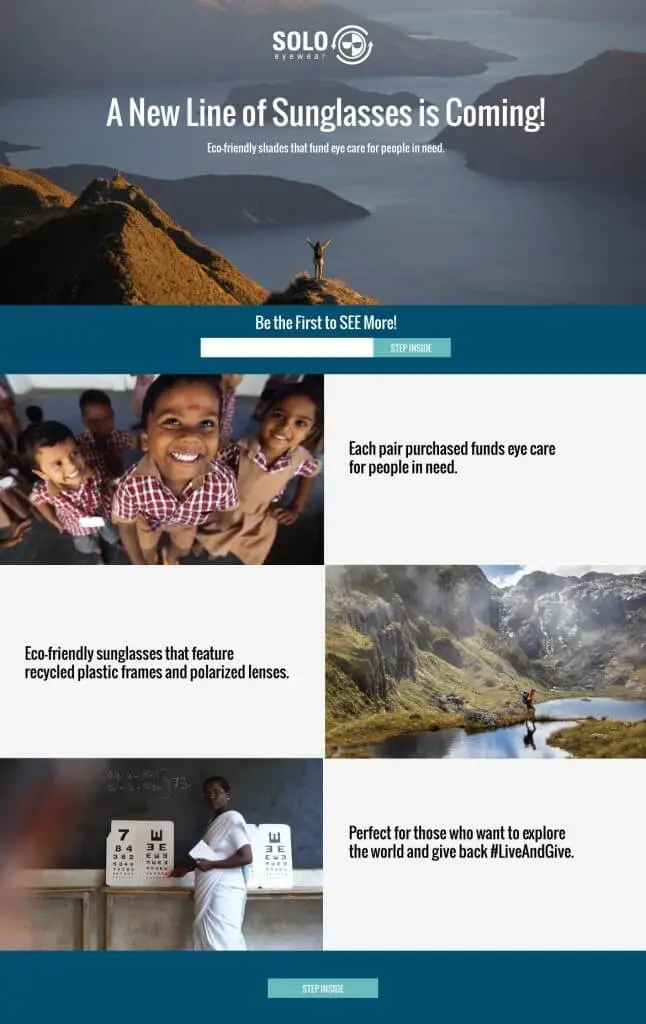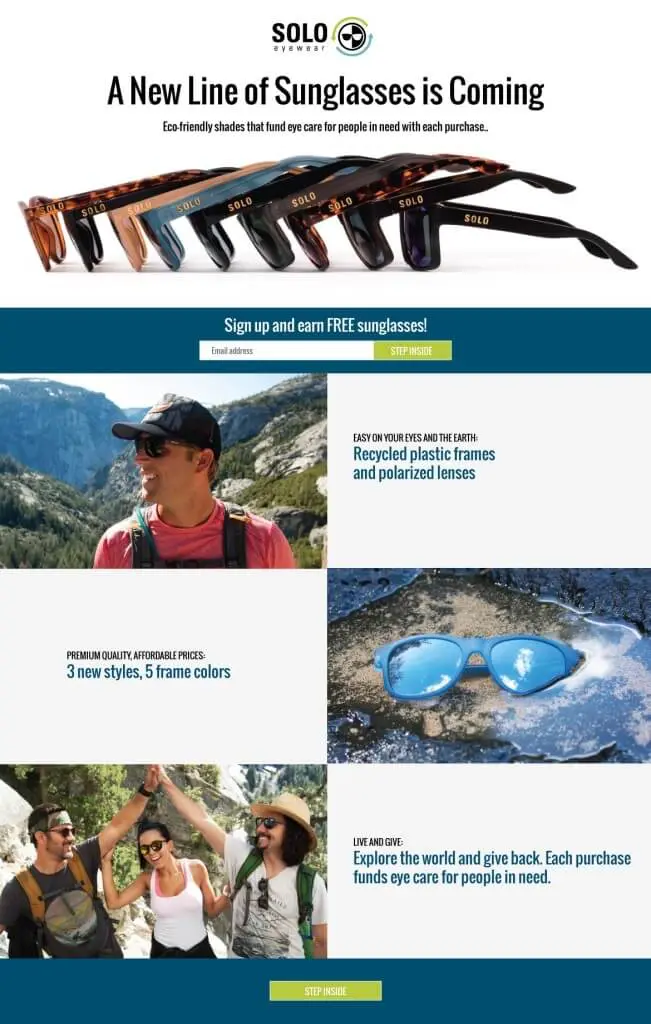30,487 leads
New Leads
The number of subscribers that came directly from the campaign
98%
Referral Rate
Percentage of leads coming in from a friend
$20k
Kickstarter Goal
Amount needed to be fully funded on Kickstarter
Key Takeaways
Always be launching!
New Product = New Launch
You don’t just put new products in the store without telling anyone. You’ve got to build anticipation with a campaign that grows your audience.
Make it Personal
They made all their emails personal and told their story. They didn’t pretend to be something bigger than they were.
Make Rewards Achievable
They made it easy for people to earn rewards in their email referral campaign and had prize levels people felt they could really get.
Engage & Amplify Everywhere
They told their story to anyone that would listen and looked everywhere for places to promote their new product. Then they advertised to amplify the best stories.
"The KickoffLabs campaign reached 30,000 (leads generated) within a month and we were able to launch our Kickstarter campaign on time!"
"As soon as bloggers & influencers started picking up on it, the campaign blew up!"
Campaign Goal:
Build prelaunch waitlist for successful Kickstarter launch
Key Features Used:
- KickoffLabs Actions
- Friend Referral Tracking
- Reward Levels
- Emails
- Viral Boost
"We had over 30,000 people sign-up to our KickoffLabs waitlist."
Contest Type(s): waitlist - reward levels
Interview Bio
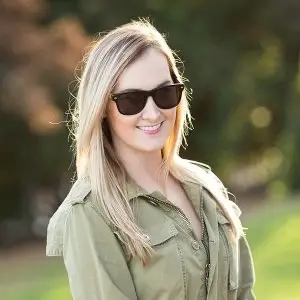
Dana Holliday Kraus- Co-Founder % Creative Director - Solo Eyewear
Dana launched SOLO Eyewear as a student at San Diego State University. Her business partner Jenny was getting her MBA, She was studying Graphic and Web Design, and both worked at the Entrepreneurial Management Center. SOLO started as a university project for both of them.
After learning that 80% of the world’s blindness is preventable and that 1 billion people do not have access to eye care in the world, Solo Eyewear came up with the concept to use sunglasses as a vehicle to fund eye care internationally.
Full Transcript
Josh: SOLO Eyewear creates a beautiful line of eco-friendly sunglasses that fund eyecare, encourage adventure and inspire individuals to change the world. In anticipation of a Kickstarter crowdfunding campaign, SOLO Eyewear used Kickoff Labs to power referral rewards, which gathered more than 30,000 leads with a 98% referral rate. In this interview, you'll learn why you don't just put a new product up for sale without doing a proper marketing launch, how to design a high converting launch page, and what rewards work best as a giveaway that encourages people to share your campaign.
Josh: Be sure to check out the show notes for this episode on our site because we've included tons of the images used, email copy, and everything you need to recreate their success. Remember, if you enjoy this episode, subscribe to KickoffLabs On Growth in Apple Podcasts. Write us a review and send any feedback to josh@kickofflabs.com. Also, if you want to go big with your idea, don't forget to sign up at kickofflabs.com to start building your audience today.
Josh: Welcome Dana.
Dana: Thank you. Thanks so much for having me here.
Josh: I'd like to understand at start a little bit about your background before SOLO Eyewear potentially, and what got you into starting SOLO Eyewear as a company.
Dana: Yeah, certainly. I'm a digital marketing consultant. My background is actually in graphic and web design, and I went to San Diego State for graphic and web design. And while I was there, I worked at the entrepreneurship center on campus, and that's really what got me into entrepreneurship at all. It was there that I met my business partner, Jenny Amaraneni, and we actually came up with the concept for SOLO, which is a sunglass line that funds eyecare for people in need, while we were students.
Dana: I used the concept as a project for an information graphics class that I was taking and Jenny used it for an international entrepreneurship course. And during our research, we learned two really startling statistics, which are that 1 billion people in the world do not have access to eyecare, and that 80% of the world's blindness is preventable. So we both did semester-long projects developing this business and the brand and graphics and data all around it. And as we did research, we learned that there was a huge opportunity for impact here and that it was something we were really passionate about.
We used KickoffLabs as a way to ensure our product launch would be a success... We exceeded our subscriber goal, converting a total of 30,487 new leads… while getting a ton of brand exposure in the process!
Dana: So we decided to launch the company upon graduating and we've been going ever since. It's been about five years. We originally launched with repurposed bamboo sunglasses and our most recent launch, which we used Kickoff Labs to generate excitement and emails to launch our most recent product on Kickstarter, was recycled plastic sunglasses.
Josh: All right. What made you want to add this second product to the line? What drove that desire?
Dana: When we started with the repurposed bamboo sunglasses five years ago, it was pretty new and innovative in the sunglass market, which was super saturated, and we used it as a way to stand out. But over time, in the last few years, there've been more and more sunglass companies that have entered the market with the same product. So our goal was to continue to be innovators in sunglass product design while also staying really true to our social and environmental ethos.
Dana: One of the thing that we've learned over the past few years is that people... We use really high quality products, they're all polarized glasses, and we work really hard to keep them under $100. But still, some people hesitate with $95 sunglasses. It's too high of a buy in for a product that they often lose or break. So we really wanted to come out with a lower price, more affordable solution for customers. We connected with a factory that specializes in injection molding, and they produce eyewear for some really major brands.
Dana: And in that process, we learned that there's a substantial amount of waste that's incurred during production. So we worked with the factory to determine how we could recycle this waste and use it to construct a new line of eyewear while maintaining a really high level of quality and integrity.
Josh: That was really neat. I love the vision for the social good. I love the health of the environment while creating a really cool looking product for people. You guys knew you wanted to launch this product, and you already had a company, you already presumably had an email list of people that are subscribed for your existing product, I assume. Correct?
Dana: Mm-hmm (affirmative).
Josh: So, why not just put the new product up for sale and then blast an email to all of your existing subscribers saying like, "Hey, we have this new product Y." Attempt to do a growth campaign at this stage?
Dana: There were a few reasons. One was, one of the most obvious reasons for most companies is product validation. We had customers that were, and still really are, married to our bamboo line. And so we wanted to use this as an opportunity to ensure that it was something that people wanted. So after developing it, we were really excited about it. We used this to make sure that other people were excited about it as well, and to generate some buzz and excitement around our product launch. We chose to launch the actual product on Kickstarter, which for anyone who doesn't know, it's a crowdfunding platform that provides easy and early access to capital through reward-based pledges.
Dana: The second reason we did this was because producing a line of sunglasses is really expensive. Especially with injection molding, you're paying for all of the molds, you have to order certain quantities. It helped us place that order for the new production and then also guide our order quantities and color design decisions. So we backed into what a successful campaign looked like. We spent a lot of time planning our strategy, with our focus on growing a large enough email list to guarantee that we would reach our funding goal of $20,000.
Dana: So in setting our goals, we used an equation assuming, based on past experiences and research, that we could convince convert 2% of our email list. So with that 2%, with an average pledge of $50, which is what the new line costs on Kickstarter, we would have to gather 20,000 emails, and we didn't have that with our existing email database. So we used Kickoff Labs as a tool to generate 20,000 emails before we launched so that we could guarantee our success upon launch.
Josh: Awesome. So to reiterate, and this is a fairly common desire, is that your goal is to have a large enough funding on Kickstarter, not achieve the goal. You wanted to achieve your goals on Kickstarter, and in order to do that, you felt like you'd have a conversion rate around you between two or 3%, but you realized you didn't have a large enough email list at the time to do it. So your challenge was to grow that email list large enough so that a 2% conversion rate would help you achieve your Kickstarter goals?
Dana: Certainly. Exactly.
Josh: Okay. Talk to me about building a landing page. You already had a website, you probably already had some people that could build a website. Why not build a collection tool yourself or code it yourself?
As a designer, the integrity of our designs is very important to me. There are a lot of WYSIWYG and templated design tools out there that make it difficult to achieve your desired design. Once I logged in to KickoffLabs, the tools were simple but I was also able to easily do custom design. Along with implementing & managing the social referral program for us, it was a no-brainer."
Dana: I think this is a fun question because we do have the team in place to build your own website. As I mentioned, my background is in graphic and web design and we have a really early team member that we work closely with who does development, so we could have done it ourselves. And the reason we didn't was the social referral part of it is actually pretty complex. My business partner is the one who showed me Kickoff Labs, and I was really hesitant because as a designer, the integrity of our designs is really important to me. And there's a lot of wizzy wig and templated design tools out there that it's really difficult to achieve your desired design.
Dana: So we were researching the most effective lead generation tools and the keys to viral launches from campaigns like Harry's and the Anthem Boxers. We were really drawn to this referral reward campaigns, and we knew that building a tool like that would take a lot of time and energy. And once I logged into Kickoff Labs, I realized that the design process was actually... the tools were simple, but you were also able to do custom design. So once I learned about that, it was just easy to do custom design and implement and manage the social referral program. It was a no brainer for us.
Josh: Awesome. That's great to hear. We'll talk more about the referral program in a second when we get to the Thank You page. I want us to start just talking about this launch page that I've been showing for a little bit where it says at the top, "A new line of sunglasses is coming. Eco-friendly. Shades that fund eyecare for people in need." And then you ask people to call to action to be the first to see more. And then and then you have a, "Step Inside," as the call to action. I'm curious how you guys came up with the choice of the design, the layout, but specifically also the copy that is on the page.
Dana: The design process is a lot of trial and error. We spent a ton of time reading up on, like I said, successful previous landing pages and modeling our content design and layout after companies who had already paved the way. There are few great articles on Tim Ferris's blog about gathering emails and hacking Kickstarters, and we followed those guidelines pretty closely. We kept the layout of the page very simple to avoid from people being distracted from the intended goal, which is obviously to leave their email address, and then step two, share with friends.
Dana: The messaging is all very short and sweet. The page layout is simple. And I think the images that we selected were really impactful. The call to action is front and center. It's in your face. As far as the messaging, it's kind of funny, we tested messaging throughout the campaign and learned like you have to be extremely literal. One really great example of that is, the original banner up there said, "Eco-friendly shades that fund eyecare for people in need." And a lot of people would go to the site, read that and think, "I don't need eyecare. These aren't for me."
Dana: So we had to add the messaging, "With each purchase," at the end just to really bring it full circle. And for example, that call to action on that page, "Be the first to see more," was not our most successful. People responded better to straightforward than enticing, like, "Sign up and earn free sunglasses." There was actually a second landing page that I submitted as well. Oddly enough, they actually had pretty similar results, but one page took off before the other, so we weren't really able to compare them accurately.
Dana: Which was a bummer because as a business, we struggle often with trying to find the balance, "Is it our mission of funding eyecare or is it just the product?" So this page focuses on materials, construction, price. It's super literal, straightforward. It shows you the product. If you look at the analytics of the two pages, their conversion rate is very similar, but this page in particular was the one that got picked up and then just like reposted and reposted and reposted, so it's the page that was seen by 90% of viewers.
Josh: I'm guessing... Personally, I like this page better. It was just probably more my opinion because I prefer to have the numbers say it. But what I like about it is in that hero image, is to the point you said earlier about being more literal, this page is much more literal than the previous page. And I think that's really important for most companies. Some people think that it's beating customers over the head, but I think it's important to be straightforward and say like, "Listen, this is what we got, our new line of sunglasses is coming. And then you go friendly shades that funds eyecare for people in need with each purchase." Like you said, very specific.
Josh: And then a little bit more specific call to action of, "Sign up and earn free sunglasses." Your teasing and rewards there on the first page I think is a best practice for using a tool like ours to do the referral campaign. You don't want to mention it too much, but you want to tease it on this first page. And then like you said, you talk about the product to those first two featured areas, like the recycled plastic frames, the styles, the colors. But then you do still mention it at the end that there's this component that you are giving back in several ways with the purchase.

Josh: So let's move on to the referral program. And I'd love to talk to you, because we get questions all the time with people trying to decide what sort of rewards they want to give and what they want to do with the referral program. What I see here is, first thing at the top, you thank people for signing up. I love the picture of the dog with the sunglasses. That is awesome. And it's looking at the copy, which is actually important because your eyes follow where people or other animals are looking at on the page. So I really love the layout that you did there with that hero image in the desktop view there.
Dana: Thanks.
Josh: And it says, "Don't leave your friends behind. Invite friends and earn products. Share unique link via email, Facebook, Twitter." And you've got the share buttons there. And then it looks like at five, you're giving $15 off, at 25 a pair, and at 50, the first receive the new plastic SOLO glasses. How did you decide on these reward levels that that's how you want it to reward people?
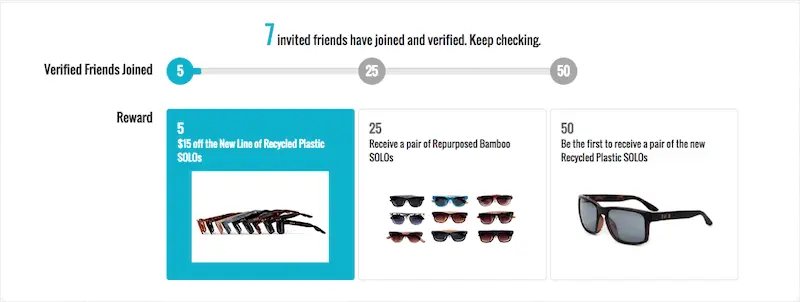
Dana: We spent a lot of time circling around what we wanted to give. And I think I heard it in someone else's interview, and I'm just going to reiterate it. In order for these campaigns to be successful, you have to be willing to give something away. It really is crucial because people are then incentivized. It also has to be attainable. So for us, like a pair of sunglasses is not a super low cost giveaway, but the majority of people don't reach that level. What they do reach is the first level where you're providing them a discount code and then you're further incentivizing them to purchase your product.
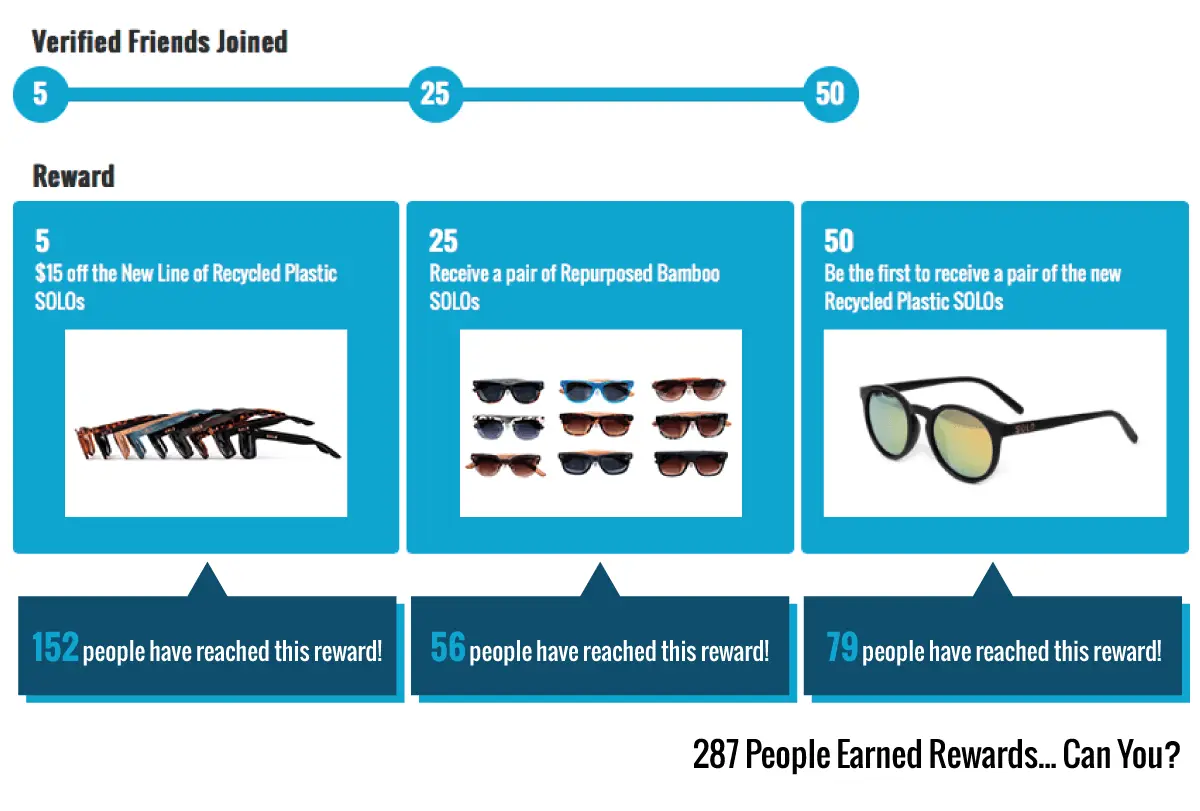
Dana: So we worked with what we had. We had a line of bamboo sunglasses and we had a new line coming out of the recycled plastic sunglasses. So interestingly enough, the highest reward level was a lower priced product than the second tier because it was like the new and exciting thing that was coming. So the way we were able to handle some of this was that we worked with excess inventory that we had of the bamboo collection for that giveaway. And then the recycled plastic, with the injection molding, you have to get such high quantities that we just dedicated.. We said, "Okay, in order for us to gather 30,000 email lists, this is worth it to us. We're going to give away our new product."
Dana: And really, if you think about it, the people that are reaching the $50 reward level are influencers. So for those people that have your product, it's not a bad thing. Those are influencers, they're kind of like your butterflies, they're out in the community, they have a lot of clout.
Josh: It's a common question at these kind of levels, how many people got to the 25 and 50? Do you know off head the rough numbers of people? Because I always hear the fearful customers, like, "What if everybody gets 50 referrals and I have to give away all of this product?"
Dana: I think if everybody got 50 referrals, that's a good problem to have, but it's just not what's going to happen. About 110 people earned two pairs of glasses. So the way it worked is, each level that you reached, you also got the levels beforehand, so 110 people reached that top level. 70 people earned one free pair, and then the remainder were in that like zero through five.
Josh: Great. That's about what I'd expect, but it's good to hear actual numbers. I think people will appreciate it. So thank you for sharing some of those numbers. It is a fear of people have going into a campaign like this and you're not knowing what the right motivational tools are to get people to share. So when people click to share, you can come up with a message when people share and a hero image. What kind of thought went into the sharing messages? And I'll show the Facebook and we'll go into the Twitter and then the email sharing message.

Dana: Let me look at that. "A new line of sunglasses is coming! [inaudible 00:19:19] go see it." We played with this a lot. We had a lot of different ideas, some were more clever, some were more literal. We spent a lot of time picking the photo as well. This one was gender neutral, there were boys and there were girls, they were outdoor having fun. It's a somewhat professional photo, but it also could be an iPhone point-and-shoot so everybody can relate to it. It's almost like you're sharing a picture of your buddies on the trail.
Dana: And then for the messaging, we again, tried to keep it really literal. That top headline is, "A new line of sunglasses is coming." And then down below we did use some of the, "Be the first to see." That messaging is... most people don't read it, they read what their friend writes and they read the headline. But if you do dig into it, it has the fact that you're going to be the first person to see the whole collection, it has our environmentally friendly component. And then like little bit of a preview into the referral program, invite friends, earn product.
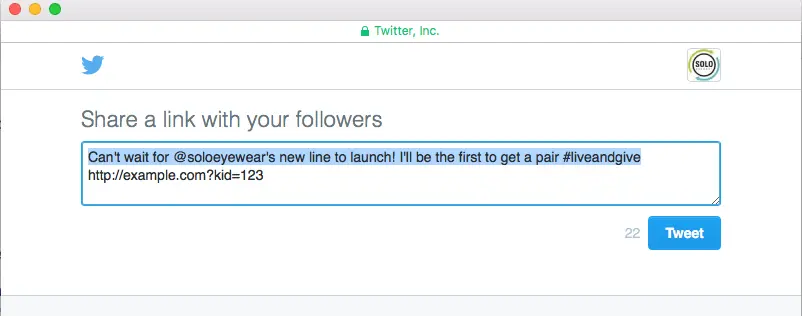
Josh: And then the Twitter message is a little bit similar, just more text space obviously. So for people that can't read it on the screen, but it says, "I can't wait for SOLO Eyewear's new line to launch. I'll be the first to get a pair." They even give... and then you link to the share page from there. I assume... Go ahead.
Dana: For the Twitter, when we approached it from like a short and sweet and like also make it something that was really slightly vague but interesting. So people are like, "You're going to be the first? I want to be the first. What are you the first of?" And it was pretty successful. The Twitter share was definitely... we definitely had the most action of the sharing link on Twitter.
Josh: And then the email share. You guys told a little bit longer story in the email share, which seems to be interesting. Instead of short and sweet, you went with like, "I'm going to tell you a story."
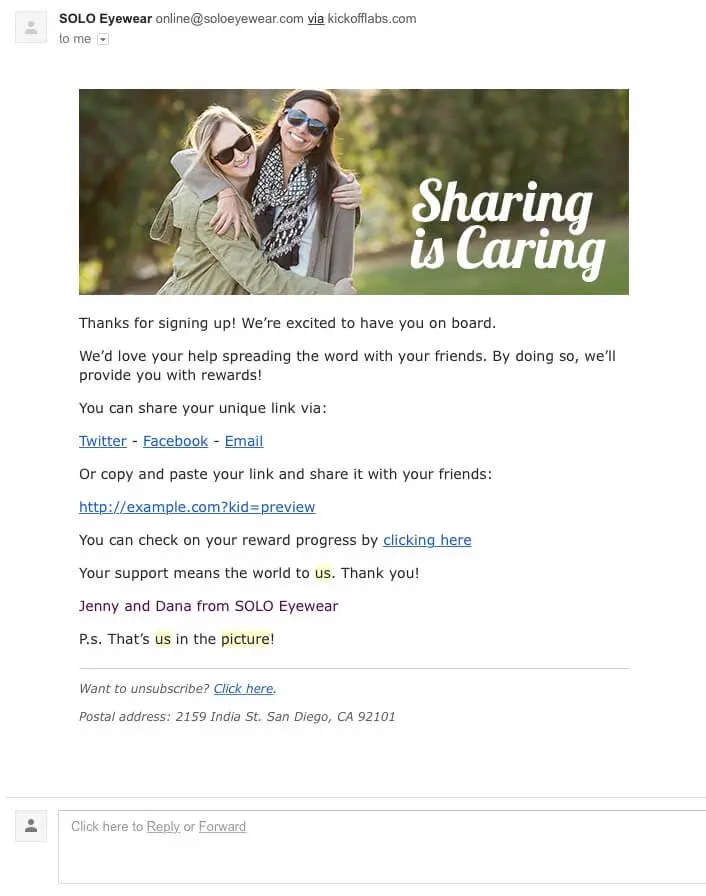
Dana: Yeah. That email is actually the day that we launched our landing page. We sent this, you'll see that one that says, "Hey mom... " We sent this to all of our personal friends, family and network, like individualized emails to people that we had personal connections with. And yeah, it goes into all of the details of SOLO, what's new, what's not, how can you help us. And then some insider access into assets that we were preparing. Like, we had spent a lot of time and energy on this video for our Kickstarter campaign, so we allowed them to get a sneak peek as early supporters of our company. So in terms of email, this one was just to our personal networks.
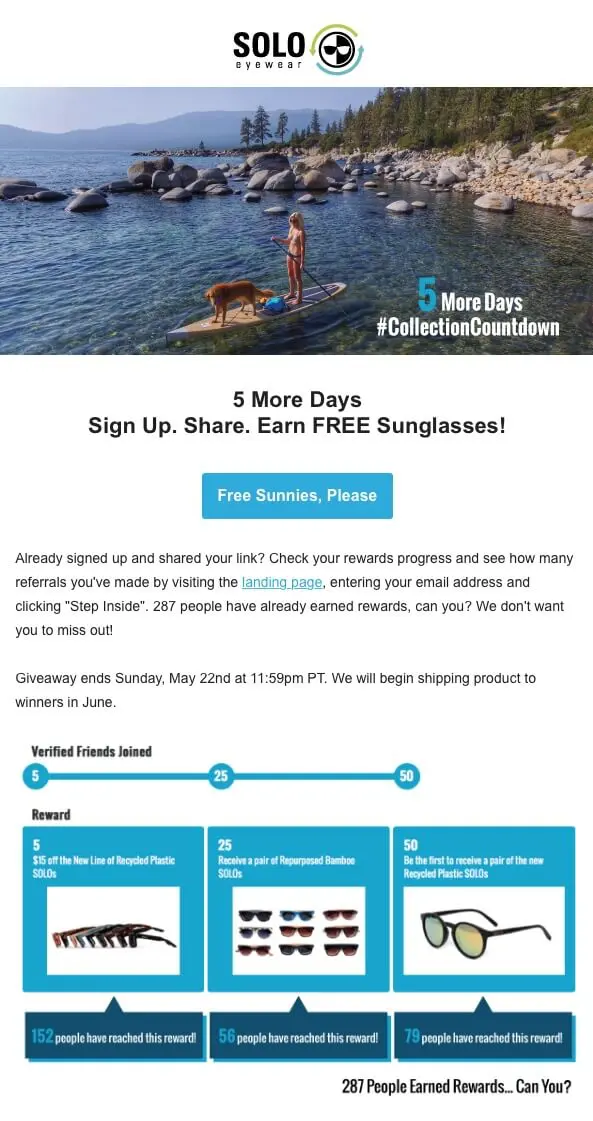
Josh: That leads into the next question which we were going to get to, which was how you initially seeded the campaign, which is an important thing. People sometimes assume they just put up pages like this and all of a sudden people will come to it, which is not always the case. In this case, you had an email that went out to basically your friends, family or really close influencers you already have that you felt like you could reach out personally to. About how many people was that?
Dana: I did that, and my business partner did that, and so between the two of us, we probably sent it out to a couple of hundred. And then we asked some other team members to send it out to their network, so they all probably sent it out to, I don't know, we'll say an average of like 20 people. This went out, this email went out to probably less than 500 people between us and then all of our team members, and interns and closer connections that we asked to forward it along. Through email marketing we did this effort, and then we also sent a very similar email, but shorter and a little bit more branded to our existing customer list, and we asked them to share. We sent that out to our existing email database, and then we had social media, so we were sharing it from our company page on Facebook, Twitter and Instagram. We did Facebook advertising, a pretty strategic and hefty paid Facebook advertising campaign and re-targeting campaign.
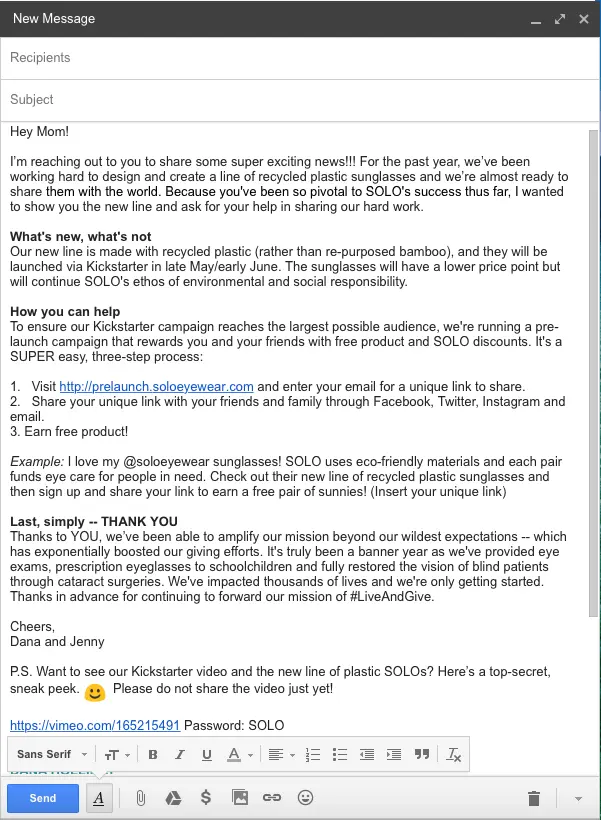
Dana: There was the social sharing on the page itself. On Instagram, we did a countdown of how many days were left. So you could say, it's like five days, four days, three days to share. And then up at the top of our bio, we had, "Share and earn free sunglasses with the link." We reached out to all kinds of partner brands that we have relationships with and asked them to create emails or social posts and help us generate excitement and buzz around this. And then we would go and we would share it on websites that were relevant, and people would be interested and click through.
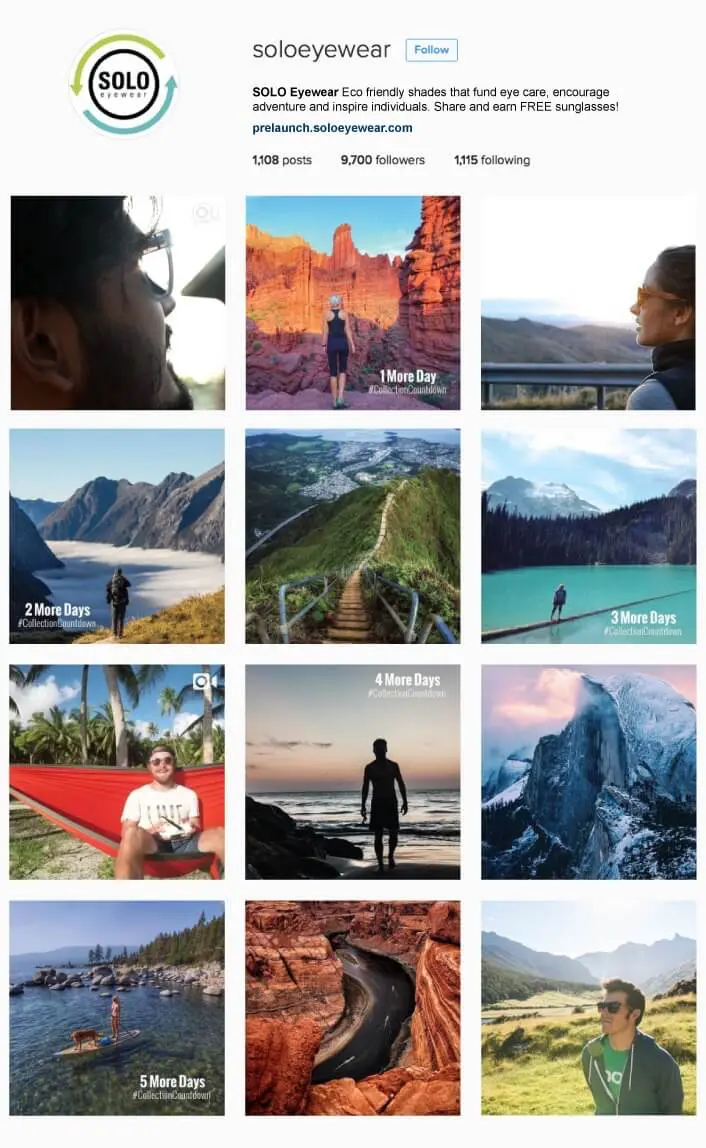
Josh: What I'm hearing from you is that, you guys left no stone unturned. You reached out to influencers, you found websites, you did Facebook advertising, you leveraged your existing social media connections, like Instagram. I do love the unique campaign, I noticed you included the image of like, the one day, two day, three days, four days left as a unique thing, something I hadn't heard before, how to you use Instagram. So that's a good trick. And you did a pretty hefty Facebook advertising campaign.
Josh: What tactics would you say were the most effective for driving the traffic? I think it's important for people to not just hone in on one thing and put all their eggs in one basket, but I'm curious what you thought was the most effective spends of your time and your team's time for this?
Dana: We find that in general, our business email is the most effective tool that we have. Email was a really effective tool, but our audience was only so big. And once we'd email it to them a few times a week, we kind of exhausted that effort. The Facebook advertising, if you can create a budget for that, it is really helpful because you can get as specific as emailing or advertising to look like audiences from the people who've already signed up for your campaign. So maybe your core network of 100 fans has signed up, then you can advertise to people who have similar interests and behaviors and habits as those people. So Facebook advertising was big for us.
Dana: Another thing that you mentioned that I didn't really touch on is, we have a Creative and Master Program, which is essentially influencers, mostly on Instagram. And we reached out to, we have about a 100, we reached out to all of them and asked them all to share this. So that was also very effective because each of those influencers has between 5,000 and 500,000 followers.
Josh: I'm kind of jumping around a little bit, but if somebody signed up, you've a fairly simply email that encourages them to share with the headline image. I assume this is again, it's very intentional. It's cute, at the bottom it says, "By the way, that's us in the picture." Well, there's something that I tell people is to make the emails as personal as possible, so it seems a little bit less like a robot. It's just a good little note that to people, it's a personal request.
Dana: Yeah. We certainly wanted to convey that, like, "This is us, and by supporting our company, you're helping support us on our mission." And we try to be really transparent and authentic brand. So it was very natural for us to send out personal emails like this. And we actually used that strategy throughout the campaign. We usually will send like your really templated branded emails, but throughout the campaign, we sent a lot more plain texts emails that were kind of heartfelt and from us personally.
Josh: You guys were sending out an email to remind people they had five more days to share?
Dana: Yeah. This one was kind of fun, we came up with the idea too, they had five days left of the campaign. And what we realized was that people would share it and either, they generated a lot of leads or they shared it and they were done. So what we did here is we took the screenshot of how many of that page, thank you page that showed you how many leads you'd gotten. And then below it we put, "152 people have reached this level, 56 people have reached this level, 79 people have reached... " So that it was attainable. People were like, "Oh, people really are reaching 50 or 25 leads or five leads, I can do this." And it was just a little bit of a morale booster.
Josh: Yeah. And I think this is important, something that comes up a lot from customer questions in these interviews, is that concept of engaging people throughout the campaign. You shouldn't view any of these campaigns as a set and forget it, like, "I set it up, I set my Facebook advertising budget, I did my first Instagram share and boom, I'm done." And clearly, you guys were in Instagram, you were doing a campaign with how many days left. And then you had emails like this going out. So about how many kind of, I would call them re-engagement emails for this campaign did you guys send during the time?
Dana: I was trying to figure that out as I was preparing for this. We definitely had the thank you email, we have this email then we had a launch email as well. So there were at least three. There might've been one or two more, but really, we do automated emails on our website. We have these types of campaigns set up where one day after signing up you get this email or five days later or 10 days later, or two weeks later. But with this campaign, we had to really, really walk the line between over-communicating because we didn't want to lose leads before we launched by over-communicating with them and annoying them, by being ever present in their inbox.
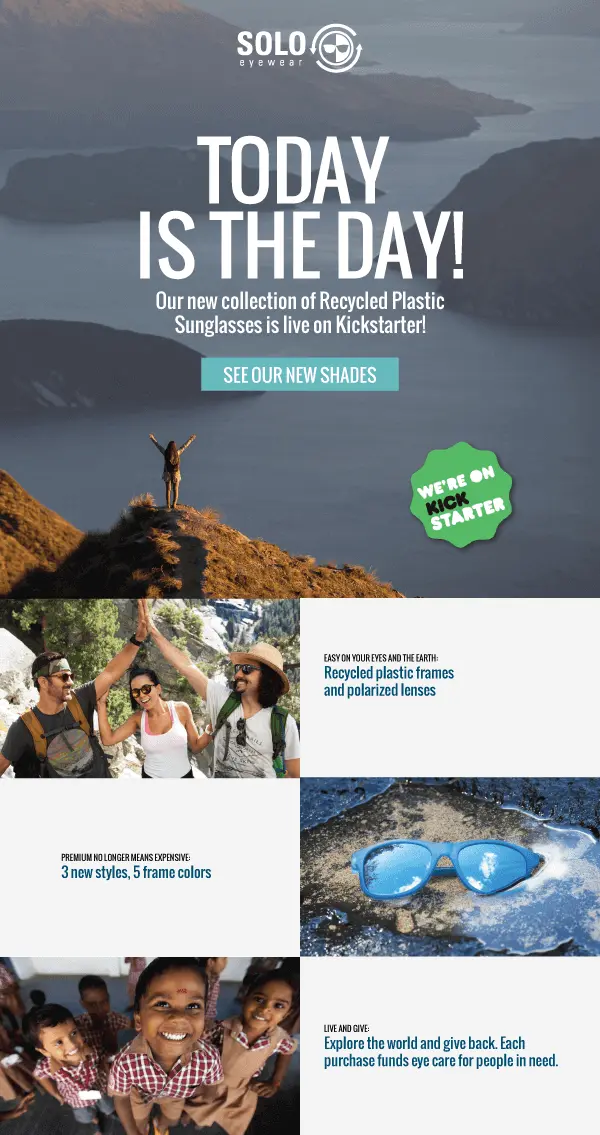
Dana: We tried to keep in contact, keep engaged without over-communicating. So we sent probably three or four, and the campaign was a month. So if you'd signed up in the very beginning, you would have gotten four emails from us, one a week.
Josh: I really like the call out, I really like the how you made it feel attainable, which is something, I think one, it's attainable because you set the first level at five for rewarding. I think you just in general... I see people that set rewards starting at even 10 or 20, and it starts to feel unattainable if the first level is at 10 or 20, because I ask myself like, "For the space, I'm not an influencer, can I get 10 to 20 people to do anything on a given day?" Probably the answer's no. And so it would feel to me like, "Oh, why would I bother even sharing it if I'm never going to get to 25, but five, I could maybe if I could get to a level of like five."
Josh: And then you're showing people that, "Yeah, people were getting the 25 and 50." And so I like that technique of just showing people that, "This can happen. People are getting these kind of traction when they're sharing it. And so you should go ahead and share the link as well." This was something that was unique to you guys, I haven't seen anybody else do it. And so it's useful to call out as a tactic for re-engaging people and making it feel believable that they can earn something. Let's talk about something else we get asked a lot, which is what you do when you go and you launch on Kickstarter. So you touched on it, you did a launch email, so talk about today is the day, what you did with the signup page, which I've got here, what you turned it into and then what other things you did on the actual launch day when you got Kickstarter, the Kickstarter Campaign up.
Dana: Oh, wow. We have a ton of coordinated efforts on the launch day and this all happened almost six months ago now, so I didn't go back and review that. But our biggest effort on launch day was certainly, we segmented our list based on past customers or past subscribers. And then people from the referral campaign, and we tweaked the different emails so that people would respond better to the email that was designed for them. And we sent this out to the 3,000 emails we collected from KickoffLabs in addition to another 10,000 emails that we had prior to that. So that was our biggest effort was sending out that huge email.
Dana: In addition to that, we pushed really hard on all of our social media outlet, Instagram, Facebook, Twitter. Again, Jenny and I sent out emails to all of our personal networks and we worked with our ambassadors, Again, we asked them all to post the day of launch. And at this point, we had actually received enough samples that we could send them to our biggest influencers and they were able to take them out, get some cool photography so that on the day of launch they were able to push some really neat content, fresh new content. We had a video that we had worked really hard on that really encompassed our brand as in terms of like the adventure component and the give back component. And we launched that and pushed really hard there in terms of sharing the video and Facebook advertising again.
Josh: Let's talk a little bit about the numbers. Thank you for allowing us to share some of the numbers in the campaign. And there's two things that stood out, which are the two main numbers on this campaign. In case people can't read the numbers, this is just simply a chart showing the conversion rate over their campaign, and that they had an 81.9%, almost 82% conversion rate, which is really good conversion rate on the signup page. And that is most likely assisted by the fact that vast majority of people coming into the campaign were referred from somebody else. So you're seeing over 90% of the people coming to the campaign came from a referral from somebody else, which is typically when you see a conversion rate above 20%.
Josh: What gets it there is seeing that referral because 25% conversion rate for a standalone landing page would be a pretty good conversion rate. The way to beat that is to make it so that when people are getting the page, they have the context of somebody they trusted sent them there. And so clearly, you guys had that. And the other thing I wanted to share from this was that you guys had, you generated over 52,000 [inaudible 00:34:50] 52,000 unique views throughout the campaigns. You are getting brand exposure regardless of people that sign up or did not sign up.
Josh: For the campaign during the length of it, and just this number of 30,000 tool conversions for the campaign that came through. You were telling me interesting story before we joined about when the campaign first took off, and I'm curious what you saw happening when the campaign took off and you guys wanted to quickly scramble and change some things that were going on. So if you can just tell your experience on the day that it took off. Do you remember what events lead to it taking off?
Dana: We launched it and the first few days, like I said, we reached out to our personal networks and it was fun, my personal feed was flooded with social sharing from all of my friends and family. So in my mind, it was already successful, but it was fairly slow. And hitting refresh on the browser. One night I go to bed and I wake up, and when I wake up, I have my phone next to me and I obviously, check the campaign right away and I'm like-
Josh: We all check our important... our online numbers every morning we get up on our feet.
We launched the campaign to a modest list of about 500 people. People were signing up & referring others, and in my mind it was successful but it was fairly slow. As soon as bloggers & influencers started picking up on it, the campaign blew up!
Dana: Yeah. So I'm like, "Holy cow." Suddenly we had just more than doubled overnight. I jump out of bed and I'm looking into it, trying to figure out what led to this. And the majority of people, in the beginning, were signing up and we were getting maybe like one to two other referrals. And it was as soon as bloggers and influencers started picking it up and sharing it, and then those people were starting to get... Some people had thousands of leads. And so what I immediately realized in retrospect was that we should have verified leads, and we weren't.
Dana: So we turned on the lead verification and I had like a moment of panic where I got in contact with KickoffLabs specifically at, I'm pretty sure I talked to Josh, and he helps me come up with a solution to back verify all of the leads that had come in previously. So that was a little bit of a hiccup in our plan. And I will say, everybody should just upgrade it in the beginning and verify your leads. But a few things that we learned that I'd really like to share with people are three things. Number one is that coupon sites and freebie bloggers will pick up your campaign and it will drive a huge number of signups, which is good.
Dana: Like Josh said, you're getting a lot of grand exposure and a ton of people who didn't know about your brand before, now do. Unfortunately, these customers kind of watered down our list because they were in search of free product and extreme deals. And so it's important to really consider quantity versus quality. Number two is like I said, verifying emails is a must. And then the third is to be prepared for the aftermath. 30,000 new emails is great, but that also means you're now managing 30,000 new potential customers with unique questions. So you have to be prepared for the overflow of communications.
Dana: You're going to get questions and you're going to have to deal with fulfilling all of those orders. I got emails every single day that was like... In the verification email, very clearly states, "Click here to verify your email." And people would forward it to me personally and just be like, "Verified." So you got to just be prepared.
Josh: Yeah, absolutely. I think one thing you did that I can call out for people who realized that was important is that your rewards were tied to your product and your brand. So at least you know that people, even if they were trying to gain, there were some more people that were interested in doing it because they had an interest in sunglasses, you weren't giving away something that I would call generically useful like an iPad or not related to your brand, like a $200 Amazon gift card. And I see people that try and do those kind of things and you will absolutely get the wrong type of people on your email list if your rewards are not related to your product and your brand that you're doing.
Josh: I think your points are really valid and I think you guys also set yourself up, at least in the beginning, for some success by making sure the rewards were tied to, you had to want the product to try and get in the system, at least. You had to be a potential customer for you guys to try and do that. In the end, you got these additional email addresses, I assume you met your funding goal on Kickstarter?
The KickoffLabs campaign reached 30,000 (leads generated) within a month and we were able to launch our Kickstarter campaign on time!
Dana: We did. It was hugely successful. The KickoffLabs campaign we reached... We set the goal of reaching 20,000 email addresses and I thought that was really ambitious and I thought we were going to have to at least find other ways to boost those numbers. And we reached 30,000 within a month and we were able to launch our Kickstarter campaign on time. Like I said, the list was slightly watered down from the couponers, so we did not convert at the percent we assumed. However, we had those additional email addresses which helped us.
Dana: And in addition to that, actually, the list, since Kickstarter has been really helpful, we've spent a lot of time digging into segmenting the list and creating content that's really targeted for these audiences. And so we've built a really strong community post after this campaign and we're working on our email strategies and automated campaigns. And it's been a really great stepping stone in our entire online marketing strategy and existence.
Josh: We have one question from Okbaby, which they sell modern cloth diapers. They're launching a new stash [inaudible 00:41:18] program for moms and dads to get away from waste disposables and build a stash of reusable cloth diapers while staying within their budget. And the question that they asked, I think is a really good one for you guys, at the bottom of the chat, which is, "For Dana. What is her feelings on the actual percentage of people who are there, they're helping or the social portion of your campaign," the social good, I think they're referring to. The reason I ask is a big portion of our marketing is to point out the damage that disposable diapers do to the environment, but the reality is people just want to save money and helping the environment maybe not as bigger portion. So for you guys, you guys have been doing this for a while, running a socially conscious company, where is that line in terms of, do you think customers are just in it for the deal and the sunglasses versus they care and that you're helping the environment and giving money back?"
Dana: That's a great question. And I touched on kind of our struggle there a little bit earlier and that's why we created the two landing pages. It's this like age old question for us, like, "Are people buying our product because they believe in our mission or are people buying our product because they like the way our sunglasses look?" And the jury is still out. But what we have realized is that a large percentage of people buy our product because they like the way it looks on them or they think bamboo sunglasses are cool or they like these reflective lenses. It's really the design of the glasses that draws them in. And then the social and environmental impact is the cherry on top, so I don't think it's what draws people in.
Dana: There's a small percentage of people that are looking for companies that are socially or environmentally conscious and those people, you're going to be able to attract through your marketing efforts, targeting socially and environmentally conscious customers. However, a large majority of your customers will come to your product because they think it's cool and I think it's at a good price. And then your environmental impact, we'll be icing on the cake. It will help convert them and it will actually help make them a lifetime customer.
Dana: We have to focus on number one, really driving home what is our product, because like I said, sometimes people think that we sell eyeglasses because we fund Eyecare. We have to drive home our product and why it's cool and why you should wear it. And then after we've gotten their attention, that's when we start to tell them about our social mission and our environmentally responsible materials.
Josh: You've used summarize what I'm hearing and what I would make as a case is that, people have to like the product and want the product first, and that is the primary driver, whether the product and the benefit is saving money or if it's a cool product, they have to like that first. And the things like about helping the environment and doing the social good, those become like trust factors when people go to make the ultimate decision to buy and they're saying, "Should I put down my credit card number and do I feel good about giving this company my credit card information to purchase the product?" And that probably helps you guys at that stage of the purchase cycle.
Josh: Somebody has to decide first if they want to purchase and then you probably get... I'm going to bet if you compared yourself to a company that wasn't doing social good, that did the exact same thing that you guys were doing, and it didn't talk about the social good, that when people get to the checkout page, people are much more likely to convert than the people who don't advertise their social good on the checkout page. Thank you, Dana. I want to thank Dana for coming and answering your questions and being so gracious with their time and being open with the numbers, and what led to their success of their KickoffLabs campaign followed by their Kickstarter campaign and the company in general, which is been around now for a while and doing really well.
Josh: Now they've much larger email list as she said to try and market to. If you have any other comments and questions, feel free, you can always email support at kickofflabs.com. Again, I'm Josh of kickofflabs.com, we help people create referral campaigns just like the one we walked through today in a relatively short amount of time. And we'd love to have you try our product and let us know what you think from kickofflabs.com. Thanks again everybody for attending. Thanks again to Dana, and I look forward to seeing you all in the future. Thanks, everyone.
Dana: Thanks, Josh.
KickoffLabs Makes Contests Easy
Quickly and easily setup viral giveaways, sweepstakes, and product launches where fans earn points and rewards for referring friends and promoting your brand!
Start For Free Get a Demo